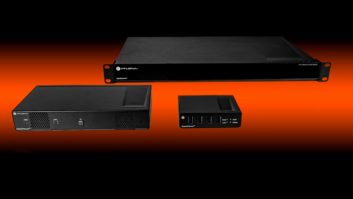
Parts of the industry claim the convergence of AV/IT has already happened; however, it appears not everyone is completely sold, particularly when it comes to video.
It does seem that video remains an application that is resistant to the apparently inexorable encroachment of IT into the AV domain.
“There are a variety of reasons why some organisations are reticent about integration,” believes Rick Seegull, senior VP of sales & marketing at Aurora Multimedia. “It might be an overall lack of knowledge, or perhaps wanting proof of concept and reliability from current product offerings – or it could simply be the challenge of compression. Most AV over IP – especially video – comes with some form of compression which, if being used in a live event, will create a slight, yet noticeable delay. That’s why Aurora is developing a non-compressed zero latency AV over IP system called the IPX w/IPBaseT.”
“Yes, there is still concern about the ability of AV to swamp available network bandwidth,” adds Brian Davies, European technical director at AMX, “and perhaps not always enough knowledge about how best to deal with it. It’s in the balance at present – but the time isn’t far off when we’ll have the technologies that will mean AV applications over the network have minimal impact.” Davies notes the recent acquisition by Harman’s AMX of AV over IP company SVSi as evidence of the direction in which things are going.
Video over the IT network isn’t, though, necessarily a problem – if the integrator has the skills to make it work, as Roland Dreesden, managing director of integrator Reflex points out.
“IT professionals are often still nervous about integrating AV,” he says. “In some government applications, for example, there are concerns about transporting sensitive video and audio data over the network. Then, there is the issue that, historically, IPTV and other streaming solutions generate heavy bandwidth use on networks when not configured properly. Some Ethernet and IP networks have been built up in an unplanned manner, and may have pinch points or bottlenecks that are sensitive to increases in network traffic. The risks associated with these products/solutions across a client’s network can be eliminated through communication and planning with IT departments.”
Complementary skills
The point is well made. The relationship between AV professionals and IT professionals is often portrayed as an adversarial one – whereas, in fact, it can easily be one in which the two sides bring highly complementary skills that are mutually valued.
And if integrators are responding to the changing dynamic, so too are manufacturers.
“Our experience is that most IT managers still want a separate network to be established for the AV infrastructure at this point,” notes David Jones, international sales manager at Lightware, “but that’s not to say we don’t see the benefit of supporting video over IP – we certainly do. That’s why this will be a big focus for us moving into the next year or two, although we’re not yet seeing the overwhelming market demand that many claim to be seeing. The gap between the two industries is certainly closing, but not at a rate that many seem to think.”
Ooms points out that provision of an Ethernet port and WiFi support are now becoming commonplace, while Seegull refers to his company’s commitment to web-based control for more than a decade.
“Go back seven years: I had a network port on a scaler,” remembers Kevin Porter, who is manager, control and collaboration at Kramer. “Now, the scalers have integrated web browsers, alerting capabilities and so on. Why have IP control sitting alongside RS-232? How long before the RS-232 port disappears?”
In fact, he believes the change is even more fundamental.
“Today, products are becoming software, not hardware,” he says. “That means that it’s a business that’s starting to depend on programmers, rather than engineers.”
AMX’s Davies is philosophical. “When you see customers and technology moving in the same direction,” he smiles, “you need to be sure you’re going in that direction too.”
That statement raises the question: why are customers moving in the direction of integration of the two disciplines? The industry is clear that there are numerous advantages – and very few disadvantages.
“End users gain cheap infrastructure, easy BYOD integration and limitless access,” says Stijn Ooms, who is director of technology at Crestron. “On the downside, depending on the codec, they may lose some video quality and add latency.”
“It’s all about ease of use,” adds Porter. “Hunting for VGA, HDMI and DisplayPort plugs doesn’t compare well with connecting via WiFi. It’s a technology everyone’s familiar with. Yes, mDNS technologies like casting which broadcast to the network are fine for the home, but are challenging on large, multiple-connected networks.”
“Organisations can reduce the need for one-off, silo projects that carry extra resourcing costs if the overall solution is fully integrated into business processes and is repeatable and saleable across further locations and geographies,” offers Andy Nolan, VP UK, Ireland and Northern Europe, Lifesize.
“Decisions on solutions can be made faster,” believes Dreesden, “and that’s helped by having a single point of contact on both the customer and the integrator side.”
“Lower cost of installation, fewer products to install and simpler cabling infrastructure are some of the advantages of integration,” chimes in Seegull.
Victim of success
The single most significant reason for integration can, however, be attributed to the fact that, in effect, AV technology has become a victim of its own success. Once, the state of the art was acetate foils on an overhead projector; now, AV is of fundamental importance to many businesses. It has, to all intents and purposes, become mission-critical, and is an asset that the large majority of companies cannot afford to be without for any length of time – much like they cannot do business without their IT infrastructure.
Aurora Multimedia solutions
AMX control systems
Reflex AV integration
Lightware distribution solutions
Kramer switchers and routers
Crestron control systems
Lifesize videoconferencing solutions







